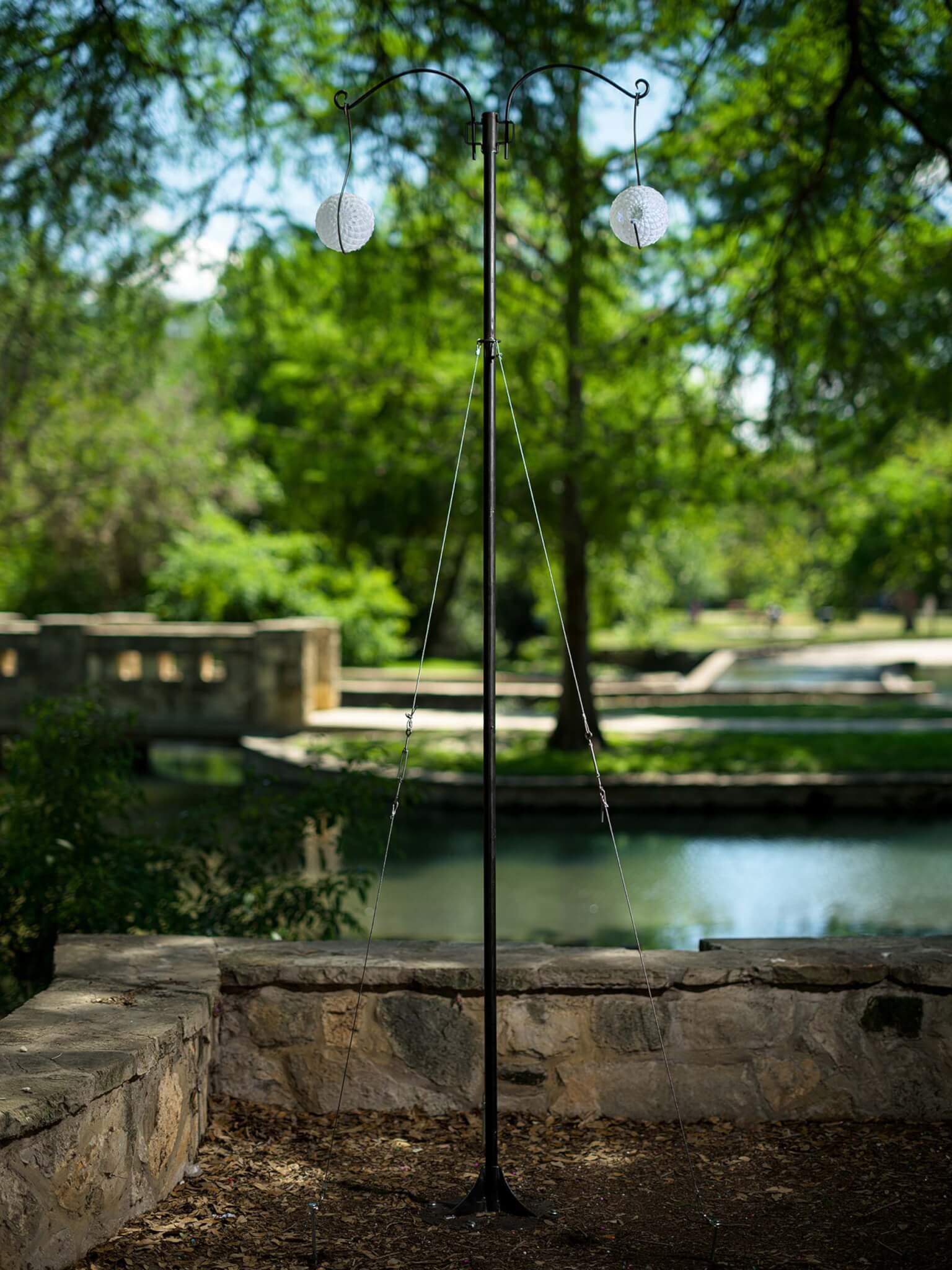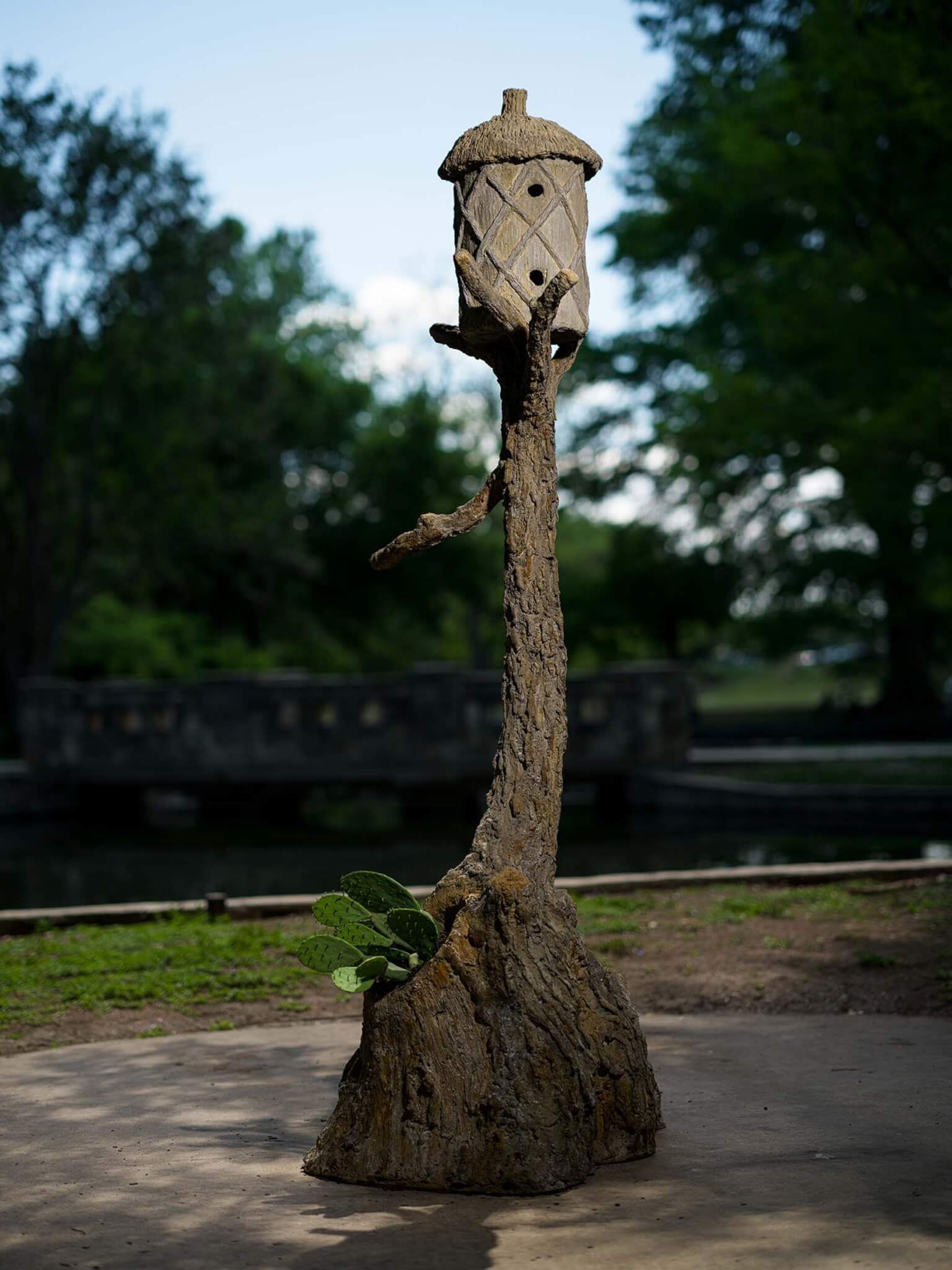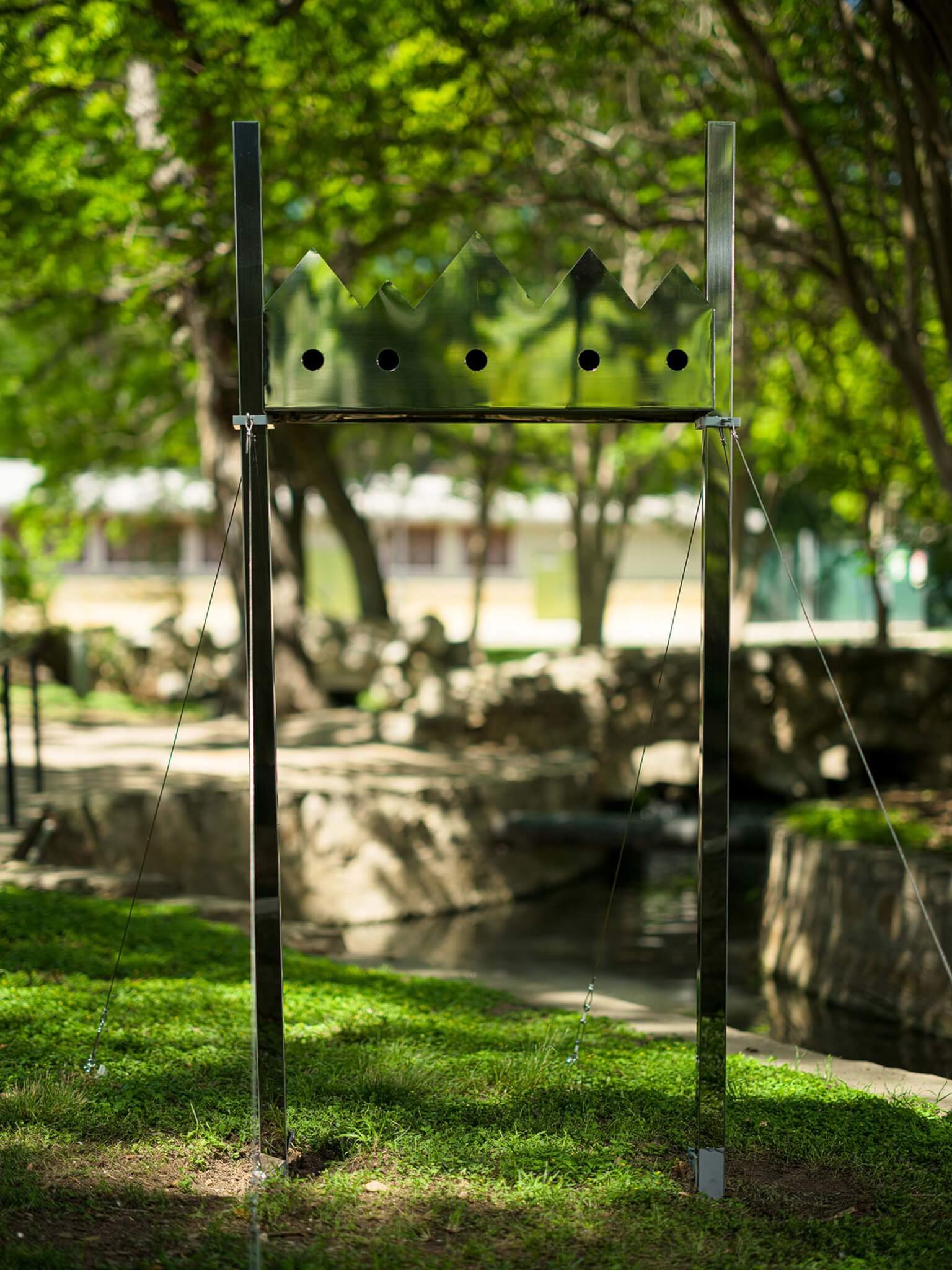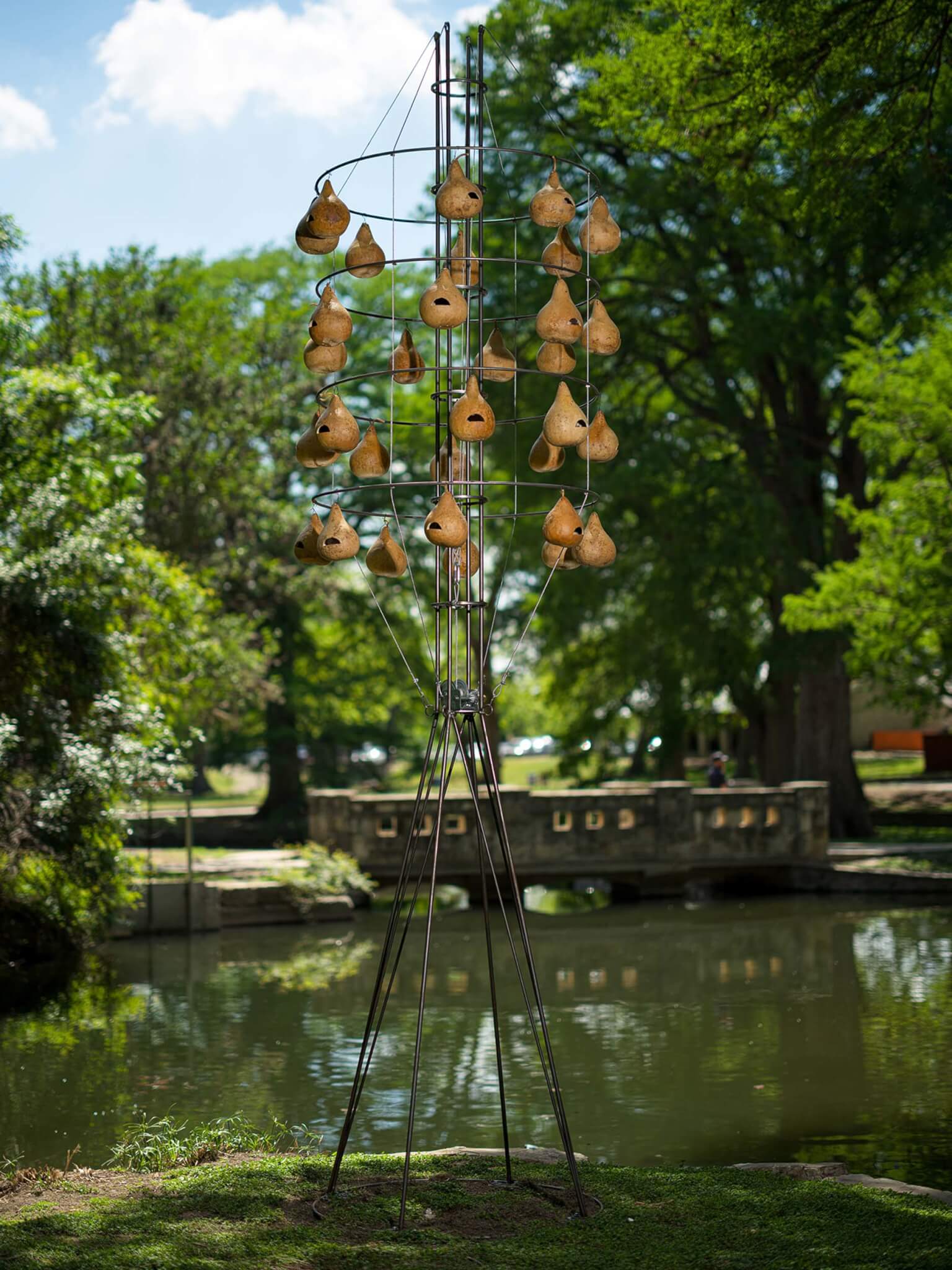Birdsong Brackenridge, a San Antonio rendition of For the Birds on view last summer at Brooklyn Botanic Garden, spins an ecological message where it’s needed most
The drive on I-35 from Austin to San Antonio unfolds like a master class on suburban sprawl. Over the last couple decades, the two Texas cities, separated by some 80 miles, have grown to be nearly contiguous. Where before rolling farm fields and wooded river bottoms were but punctuated by the intervening towns—Buda, Kyle, San Marcos, New Braunfels, Schertz—today there is scarcely a break in the chain of gas stations, fast food restaurants, motels, shopping centers, subdivisions, apartment blocks, and industrial parks. The freeway offers many exits but no relief.
To alleviate the mounting anxiety created by this onslaught of development—the road’s billboards scream out for attention—I played Brian Eno’s Discreet Music on the car stereo. The music’s murmuring ambient strains vaulted my consciousness high above the rushing traffic, up to where a flotilla of fluffy white clouds sailed peacefully through the azure sky.
It was a poignant way to make my passage to Party in the Park: Birdsong Brackenridge, a fundraising gala for the Brackenridge Park Conservancy organized by Suzanne Matthews, director of the San Antonio–based architectural lighting manufacturer Lucifer Lighting. The event was something of a revival of For the Birds, which opened at the Brooklyn Botanic Garden last summer. As with that event, several prominent architects were invited to design birdhouses, and Grammy-winning movie music supervisor Randall Poster played cohost. Poster’s For the Birds: The Birdsong Project—a 20-LP box set containing more than 200 tracks of original bird-related music and poetry, the proceeds of which go to support the Audubon Society—served as inspiration for both parks’ birdhouse initiatives.


I met Poster, who was in San Antonio for the gala, along with several of the birdhouse designers, at an intimate gathering at the Matthewses’ Alamo Heights home. He said he conceived of the project midpandemic while reflecting on the fact that songbirds make the most beautiful music. Everyone loves songbirds, and yet their numbers are falling drastically due to ecological depredation. Discussions about the environment often trigger political reactions that derail any hope of reaching consensus on appropriate action. Maybe if we talk about songbirds instead, Poster thought, agreement will arise.
To expound on Poster’s thought: To protect songbirds, you have to protect their habitat, meaning you have to think differently about development, meaning you can’t go on repeating the sort of suburban sprawl that is making Austin and San Antonio touch each other, meaning you make and pour less concrete and drive fewer miles, meaning you’ve just reduced a region’s carbon footprint significantly, meaning climate change has been mitigated, meaning the flora and fauna that support songbird populations continue to flourish in place—and on and on.
Brackenridge Park was an appropriate setting for this rendition of For the Birds. Texas is the most bird-diverse state in the nation, with more than 540 species in residence—about two-thirds of the species found in the entire U.S.

At the same time, the state is also overachieving when it comes to destroying avian habitats. Around San Antonio alone, it is estimated that in the next 15 years there will be more than 450,000 acres of habitat loss due to interminable development, which arrives with its concomitant light pollution and increase in glass, pesticides, and invasive species. Sited just below the headwaters of the San Antonio River, Brackenridge Park is a 349-acre green space amid the city’s sprawl. The conservancy is currently fundraising to restore as much natural habitat and native vegetation in the park as possible, among other improvements.
Matthews invited ten architecture studios to design birdhouses for Birdsong Brackenridge: Marlon Blackwell; Angela Brooks and Larry Scarpa of Brooks + Scarpa; Roberto de Leon of de Leon & Primmer; Craig Dykers and Elaine Molinar of Snøhetta; Ted Flato of Lake|Flato; Everett L. Fly; Michael Imber; David Jameson; Tom Kundig of Olson Kundig; and Judy Pesek of Gensler. While the birdhouses were designed to provide homes for birds, the projects also address Poster’s ecological imperative in varying degrees.


Jameson’s project put a particularly fine point on things. A new “multifamily” habitat for bluebirds, it comprises a series of gables constructed of mirror-finish stainless steel, providing, as the architect said in his statement, “reflection for humans to realize that without taking care of our natural environment, we’ll only be looking at ourselves.”
Dykers and Molinar’s residence for the Carolina chickadee took a different, though still cheeky, take on being ecological. Called Huevo al Nido (“egg to nest” in Spanish), it’s composed of an upcycled ostrich egg found at a Brooklyn flea market attached to a piece of repurposed Douglas fir taken from a demolished commercial building in Queens, and a perch made of a moss-covered branch of a 140-year- old catalpa tree. “It’s a single-family adaptive reuse project,” Dykers said. San Antonio native Fly, an architect and landscape architect, also chose the upcycling route, reusing a chunk of a fallen heritage pecan from the park with a hole for nesting already in place.


Two of the architects designed houses for hummingbirds—or, really, nesting sites, as hummingbirds don’t favor human-made houses. De Leon’s, called Tapestry, is a framework of twisted copper-hued aluminum wire of the sort used for training bonsai plants. Pesek’s is made up of two 3D-printed ovoids, the delicate forms of which are inspired by Fabergé eggs. The purple martin, another bird that lives outside the nest, also received two architect-designed abodes, both of which are multi-unit constructions. Flato drew parallels between the nation’s human homelessness epidemic and the destruction of purple martin habitat. His structure features an array of gourd-shaped nesting sites spaced on circular steel armatures. Brooks and Scarpa’s nesting sites are also gourd shaped, though smaller in size and tightly clustered together. Scarpa said they were inspired by the fact that purple martins enjoy multiple mates in their lifetimes.
Kundig also designed a multi-unit structure. Though the particular bird it’s meant for was not specified, it is a collection of four spheres from which extend very protuberant perches. To this reviewer, the proportions appeared somewhat reminiscent of the geoduck clam found in the waters near Kundig’s Seattle home. Imber, a San Antonian, looked to the cultural history of Brackenridge Park, turning in a faux bois (concrete made to look like wood) sculpture he collaborated on with Carlos Cortez, a third-generation faux bois craftsman. Blackwell’s submission, Casa de Ave, is a cross between a bird dwelling and a light fixture shaped like an abstracted bird’s head. The entrance to the house is through the beak. “We had great fun researching and conceiving the Casa de Ave,” Blackwell said in a statement. “It’s not architecture, but certainly has an architecture… like the birds themselves.”


For the Party in the Park, the birdhouses were perched atop high poles beneath heritage cypress trees. The exceptions were Imber’s, which has an integral concrete pedestal that resembles a tree stump, and Jameson’s, which is set at eye level on stainless-steel legs so that revelers can catch a glimpse of themselves in its mirrored surfaces and receive its ecological message. After the party, the birdhouses were taken to the McNay Art Museum, where they’ll be on display for a time before being returned to the park and placed strategically where birds might actually use them.

But on that April evening, there they were, attracting admiring glances and words from conservancy members and other guests who attended the gala in “garden festive” attire, mingling beneath the dwellings/sculptures, cocktails in hand. In the distance, the boom of antibird pyrotechnics sounded at regular intervals, charges set off to scare away the many egrets who have roosted in the park since their traditional rookery south of San Antonio was destroyed by human encroachment. As the light faded, so did the explosions, and we sat down to a dinner of filet mignon set in a nest of raw vegetables while being entertained by musicians invited by Poster, who played bird-inspired music, and a local ballet troupe, who danced bird-inspired dances.
Aaron Seward works at Perkins&Will. He is the former Editor in Chief of The Architect’s Newspaper.

